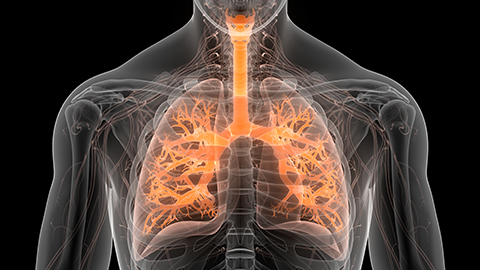Detecting biomarkers for deadly lung disease
Researchers don’t yet know the precise cause of idiopathic pulmonary fibrosis, or IPF, but they know it’s deadly. Patients usually survive about three years after diagnosis. A sudden and unpredictable increase in IPF symptoms, such as shortness of breath and dry cough, could be fatal. Thus, early diagnosis and monitoring are crucial.
Lysophosphatidic acid, or LPA, is produced during lipid metabolism. In the past, researchers have reported that the LPA levels increase in lung fluid following lung injury in mice genetically altered to have pulmonary fibrosis. Deleting one receptor, LPA1, protected mice from fibrosis, indicating that LPA receptors have a role in IPF and may be a potential therapeutic and diagnostic target.

A group led by scientists from Genentech Inc. is now studying whether bioactive lipid species can predict IPF progression. “We had initially been working on chronic obstructive pulmonary disease, COPD,” Genentech senior scientist Margaret Neighbors said. “We compared gene expression levels between COPD patients and healthy patients.”
In this experiment, the gene autotaxin, or ATX, was overexpressed in COPD, and the team already knew that ATX has a role in the LPA signaling pathway, Neighbors explained. ATX generates most of the LPA detected in blood and inflamed tissues, and previous studies showed the role of the ATX–LPA signaling pathway in lung fibrosis in animal models. The team used targeted mass spectrometry to quantify LPA subspecies and assess how it affected COPD exacerbation.
“Then, we turned our focus to another lung disease, IPF, in which autotaxin has a role,” Neighbors said. “We used the same mass spectrometry approach to determine the role of bioactive lipids in IPF for this study.”
They profiled lipid metabolism beyond LPA to compare more lipid species associated with the disease, then combined this with protein biomarker data to learn more about the IPF phenotype than in previous studies.
Neighbors and her colleagues worked with data from about 100 IPF patients between 40 and 80 years old. “Having a rich and diverse cohort helped us to examine how the different lipid species associated with individual clinical measures of IPF,” she said. “This individualistic approach can shed more light to better understand detailed connections between molecular pathways and each clinical manifestation.”
The researchers found that IPF patients had significantly higher levels of five LPA subspecies, and disease in patients with higher levels of one of these, LPA 20:4, worsened sooner than in patients with lower LPA 20:4. Also, patients with higher levels of LPAs have greater declines in diffusion capacity of carbon monoxide, which indicates decreased oxygen capacity of the lungs, an association that has never before been published.
“Our findings suggest LPA subspecies can play roles in pulmonary fibrosis through multiple pathways, rather than any key signal pathobiology,” Neighbors said. “Our study adds a road to the existing lipid map.”
In this study published in the Journal of Lipid Research, the researchers established the association of LPAs with IPF progression. Using mass spectrometry, they characterized lipid dysregulation in IPF. They hope to replicate these findings with additional cohorts and then to observe the molecular mechanisms behind increasing LPA subspecies expressions and their association with IPF.
“We are trying to connect LPAs to clinical manifestations that might be downstream of pathobiologies,” Neighbors said. “Association between higher levels of LPA and declined levels of DLCO (diffusing lung capacity for carbon monoxide) is one new road on this lipid map.”Enjoy reading ASBMB Today?
Become a member to receive the print edition four times a year and the digital edition monthly.
Learn moreGet the latest from ASBMB Today
Enter your email address, and we’ll send you a weekly email with recent articles, interviews and more.
Latest in Science
Science highlights or most popular articles

Bacteriophage protein could make queso fresco safer
Researchers characterized the structure and function of PlyP100, a bacteriophage protein that shows promise as a food-safe antimicrobial for preventing Listeria monocytogenes growth in fresh cheeses.

Building the blueprint to block HIV
Wesley Sundquist will present his work on the HIV capsid and revolutionary drug, Lenacapavir, at the ASBMB Annual Meeting, March 7–10, in Maryland.

Gut microbes hijack cancer pathway in high-fat diets
Researchers at the Feinstein Institutes for Medical Research found that a high-fat diet increases ammonia-producing bacteria in the gut microbiome of mice, which in turn disrupts TGF-β signaling and promotes colorectal cancer.

Mapping fentanyl’s cellular footprint
Using a new imaging method, researchers at State University of New York at Buffalo traced fentanyl’s effects inside brain immune cells, revealing how the drug alters lipid droplets, pointing to new paths for addiction diagnostics.

Designing life’s building blocks with AI
Tanja Kortemme, a professor at the University of California, San Francisco, will discuss her research using computational biology to engineer proteins at the 2026 ASBMB Annual Meeting.

Cholesterol as a novel biomarker for Fragile X syndrome
Researchers in Quebec identified lower levels of a brain cholesterol metabolite, 24-hydroxycholesterol, in patients with fragile X syndrome, a finding that could provide a simple blood-based biomarker for understanding and managing the condition.

